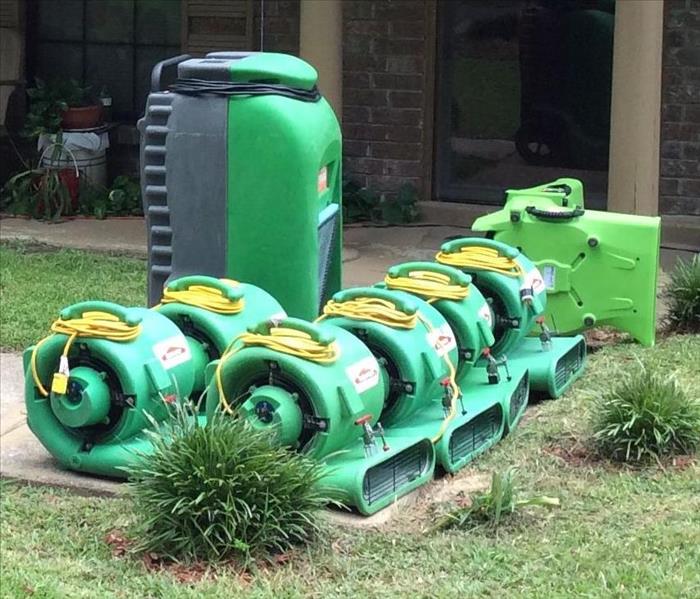What Steps Ensure That Flood Drying Happens as It Should for My Shreveport Home?
7/31/2020 (Permalink)
Extraction and drying are essential elements to our flood restoration work in Shreveport homes and involve multiple tools, technologies, and experience to complete correctly.
Flooding can present rapidly changing conditions for your Shreveport home. As challenging as these disasters can be, the right response from qualified restoration professionals can help prevent the situation from getting out of control. We have skilled experts in flood restoration and water recovery that can implement the right tools to protect your property as efficiently as possible when we arrive.
Much of the need for flood water removal for damage in Shreveport homes hinges on an assortment of extraction and drying tools. These industry-leading devices are vital in helping to manage flood losses by removing present surface damage concerns. At the same time, other technologies and machines can work on labeling other areas of interest where thorough drying might be necessary.
What Initial Readings and Details Are Necessary?
It can be essential to identify any possible atmospheric or environmental conditions that could impact the efficiency of drying your home. Moisture content is often one of the first factors to determine, and this might also include identifying where migration of flood loss effects has occurred. It is not challenging for water to find its way into structural cavities between wall systems, so we utilize sophisticated technologies like thermal imagery and hygrometers to detect moisture pockets and dampness to address these concerns as they get discovered.
Beyond standing water concerns, which can often be a substantial obstacle after flooding, we also must ensure that the entire impacted area gets prepared for extraction and drying efforts to come. Part of this venture's success hinges on isolating the affected regions of the property while preventing cross-contamination or migration of these effects to areas currently undamaged by flooding. We document conditions upon inspection with our SERVPRO DryBook software.
What Extractors Are Best for Floodwater?
Flooding almost always comes with a need for extraction and water removal. The tools used to do this vary based on the severity of the damage and where these threats might be in the house. With dozens of potential extraction units ranging from truck-mount pumps in our Green Fleet to mobile extractors like our wet vacuums, we have the right tools and technologies to address the conditions in your home after a flood loss incident. Flooding typically requires multiple water removal tools, including:
- Submersible Pumps – These pumps are often a vital need after a flood, as standing water can exist in various areas. Trash pumps are the common choice to pass debris present in natural floodwater.
- Truck-Mount Pumps – For excessive water damages after a flood, extractor trucks can have a fast and powerful impact. These pumps can remove water at 300 psi, making them the most efficient removal tool in our equipment inventory.
- Wet Vacuums – When water depths drop below two inches, pumps are less effective. Vacuums and their attachments can help to remove surface water and trapped moisture in materials like carpets.
Who Maintains Drying Equipment While It Runs?
We often set up drying tools throughout your house in the appropriate places and allow them to run for several hours or longer unsupervised. We can trust in the efficiency of our tools and technologies, and it ensures that we can help begin the restoration process without being an overbearing presence in your house. Once affected area barriers and boundaries have been established in your home, we anticipate the devices to be left alone until our return.
We can reevaluate the drying process effectiveness and modify the placement and volume of drying tools like air movers, dehumidifiers, and drying mats to suit the new conditions. There are several reasons that we do not continuously watch drying progress, and these include:
- It can save you money
- It can give you time to process the changing situations
- We are not continuously needed through the drying phases
Is the Desiccant or the Low-Grain Refrigerant Dehumidifier Better?
Dehumidifiers are a vital part of the drying process for many flood-damaged homes. The choice between desiccant and low grain refrigerant options often involves the conditions of the house and the unaffected areas or external influences like humidity levels. Desiccants can be a wise choice when dry air can get brought back into the property through the exhaust. When overly moist conditions exist outside of the house, low grain refrigerant models might be a better and more efficient option for moisture content inside.
Flooding can be a traumatic situation for your home, but our SERVPRO of South Shreveport team can help with effective water removal and drying practices. Give us a call anytime at (318) 865-4655.






 24/7 Emergency Service
24/7 Emergency Service
